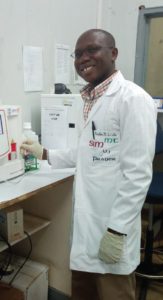Stephen continues the story of Tangale missionaries
AfriGO Team
 Stephen Nitte looks completely at home amidst the laboratory equipment at Partners in Hope Medical Centre in Malawi, southern Africa. His most natural expression is a big smile. A missionary from Nigeria, his qualifications in medical laboratory science have equipped him for this vocation, but his conviction that those living and dying without Christ is compelling him to take his skills across borders.
Stephen Nitte looks completely at home amidst the laboratory equipment at Partners in Hope Medical Centre in Malawi, southern Africa. His most natural expression is a big smile. A missionary from Nigeria, his qualifications in medical laboratory science have equipped him for this vocation, but his conviction that those living and dying without Christ is compelling him to take his skills across borders.
At first glance, Stephen, a Tangale from north eastern Nigeria, may seem like a trailblazer, forging a new path from his home town of Tal in Gombe State, to become a cross-cultural missionary. But Stephen’s story is simply the most recent chapter in a story of Tangale missions that dates back, not 20 or 30 years, but a full century, to the time when the gospel first arrived.
The first Tangale to place his faith in Jesus was a man named Karga, an orphan who snuck into the mission compound, and would soon teach the missionaries his language. Karga gave his life to Christ in 1919 and was baptized the following year. He was the first to enroll and graduate from literacy classes, and to become a teacher.
Missionary Harry Harling describes Karga’s devotion: “Faithfully and conscientiously, he continued his daily tramps to Billiri suffering the full heat of the Sun at mid-day, unperturbed at exposing his bare feet to bite of deadly snakes lurking along the pathway as he trod his way home after dark…. Soon quite a group was sitting at his feet, learning to read and hearing the wonderful new things from God’s word.”
The small churches that began to emerge in Tangale land in the 1920s were missions-minded from the start. Reuben Goje Maiture, a historian and lecturer in Christian Religious Studies at Ahmadu Bello University in Zaria, Nigeria, writes, “SIM taught the converts the biblical principles that every ‘convert is a witness.’ Realizing this, the converts became quintessential evangelists and within a short time transformed Tangale society. All graduates of the literacy classes eventually were commissioned to be teachers and evangelists.”
Western missionaries’ call for evangelists resulted in new missionaries stepping forward to open areas in northern Nigeria. Locations among the Muslim emirates were often too hostile for foreigners to enter, let alone set up dispensaries or schools. Yet the Tangale entered easily, like “lizards in a king’s palace” (Proverbs 30:28).
Missionary Gordon Beacham recorded in 1940 that “besides a staff of one hundred self-supporting native workers,” the Tangale church “have sent twenty ‘foreign missionaries’ to Muslim and pagan tribes in other parts of the country.”
Professor Maiture writes that “the statistics of the Tangale evangelists grew so rapidly that it could be equated to, and be even greater than, the staff strength of some foreign missions working in Nigeria by then.”
The African Mission Society, now known as the Evangelical Missions Society (EMS), was founded in 1948 and has one of the largest workforces of any African mission agency today. In 1963, more than a third of the EMS missionaries were Tangale.
Today the Tangale are still ‘going north’ through Stephen, who is back home and preparing for his next assignment: Galmi Hospital, Niger Republic. The communities around Galmi are predominately Hausa and Fulani Muslims, just like the communities the Tangale entered a century ago in Gombe, Borno, Kano and Sokoto.
Is Stephen forging a new path or simply following in an old one? Both. Each generation and person forges a new path in obedience to the One who calls them out for a certain purpose. Yet the path is not entirely new either.
Stephen’s story begins with Karga, the first Tangale convert and missionary. It continues with the gospel arriving in his hometown of Tal in 1932, when two men named Sambo Bukbuk and Alkali Tal arrived as evangelists from neighbouring Billiri. The story continues with godly Christian grandparents and parents who raised up Stephen. Today Stephen is continuing the story.
Sources:
- SIM and the Tangale Factor in the Christianization of the Hausa of Northern Nigeria, 1915-1976. Rev. Dr. Reuben Goje Maiture. Published in “Transforming Africa’s Religious Landscapes” Africa World Press, 2018.
- “The Story of Billiri” The Sudan Witness, Jan-Feb 1938, Harry Harling
- A Grain of Mustard Seed, The Sudan Witness, Nov-Dec 1940, Charles Gordon Beacham.
